The combination of smartphone, networking, and internet-of-things (IoT) technologies has enabled the development of both the smart home and advanced building automation. These technologies provide increased automation, control, and security giving the homeowner or the office occupant enhanced convenience and the comforting feeling of greater safety. Wherever the homeowner or the office occupant is, they can view the status of their door lock and their windows and doors.
Engineers designing home and building security products such as smart locks and window and door sensing devices need to ensure that their devices do not create a false sense of security for their customers. Designers need to understand the protection and sensing components required to comply with applicable safety standards and to ensure safe, robust, and reliable products.
The market for smart locks alone is a high growth market and is opportunistic for innovation. The global growth for smart locks is expected to have a compound annual growth rate (CAGR) of 25 percent with unit growth expanding from approximately seven million units in 2019 to about 23 million units in 20241. The residential market will represent the majority of the growth, which will be around 70 percent.
As with smart locks, the increased awareness of personal security will drive global growth of window and door sensors, especially in developing economies. Shipments are expected to increase from about 300 M units in 2019 to around 465 million units in 20242. This growth is at a CAGR of around nine percent. The market for smart home security products is a healthy, attractive market.
Protecting Smart Lock Designs
A smart lock consists of a keypad for manual access, a wireless protocol link for smartphone access through a software application, a sensor to monitor the position of the door handle, actuators to lock or unlock the door, and sensing to detect an effort to circumvent the lock. Figure 1 shows an example smart door lock with suggested protection and sensing components to ensure reliable operation. Figure 2 provides a detailed block diagram of a smart lock; and the diagram shows the recommended placement for the suggested protection and sensing components.
Electrostatic discharge (ESD) is the prime danger to smart lock electronics. Both the user interface and the wireless interface are susceptible to ESD from the user.
The User Interface contains the keypad which a person contacts to enter the pre-programmed access code. An individual is a source of ESD, particularly in a dry environment. Designers should protect the User Interface circuit block from ESD to avoid damage to sensitive electronics.
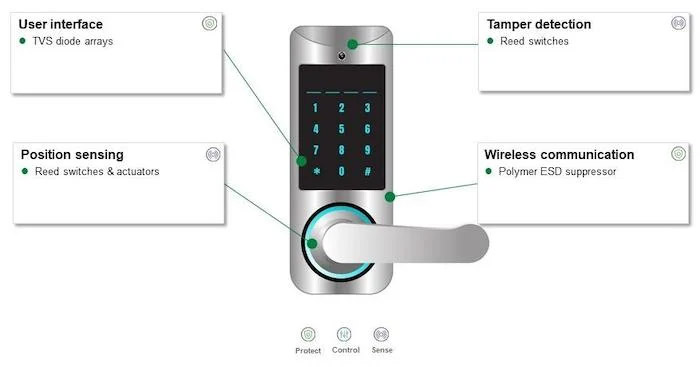
Figure 1. A smart lock with recommended protection and sensing solutions

Figure 2. Smart lock block diagram showing the circuit blocks where protection and sensing components are recommended
For ESD protection, designers should consider a transient voltage suppressor (TVS) diode or a diode array. TVS diodes are Zener diodes built with a silicon avalanche technology and can offer a minimum protection level of ±15 kV of ESD voltage. A TVS diode array can house six Zener diodes to protect five signal lines and provide a ground reference. See Figure 3. The advantage of an array is that one space-saving component in an 0402 surface-mount package can protect up to five lines.
The impact on the circuit block is minimal; a TVS diode array can have a leakage current of only 1 µA. If a higher level of ESD protection is desired, an individual diode can provide ESD protection for each signal line. A single TVS diode, shown in Figure 4 can withstand as much as ±30 kV. Whichever configuration is used, place the TVS diodes as close to the input of the circuit as possible to prevent an ESD transient from penetrating into the circuitry.
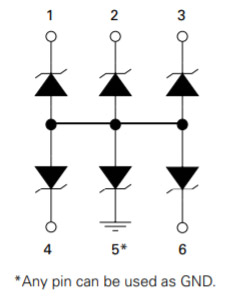
Figure 3. Example 5-line TVS diode array

Figure 4. A single TVS diode
The wireless interface links to the cellular network or a wireless LAN, a WiFi network, to communicate with a smartphone or another networked device. Since it is exposed to the external environment, the Wireless Interface should have ESD protection. The recommended component is a polymer ESD suppressor.
The value of a polymer ESD suppressor is its ability to respond to and absorb ESD transients while having a negligible impact on the characteristic impedance of the wireless interface output. Polymer ESD suppressors can withstand a ±8 kV direct contact ESD and a ±15 kV airstrike. Typical capacitance for the component is a low 0.06 pF. Response time to a transient is extremely fast, under 1 ns. Placement should be as close to the input antenna connector as possible. Figure 5 shows two configurations for polymer ESD suppressors, bi-directional components.
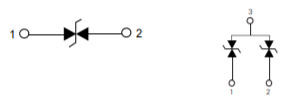
Figure 5. Configurations for polymer ESD suppressors, bi-directional components
Sensing Recommendations for Smart Locks
Detection to ensure the door is completely seated in the door frame requires a sensor. A reed switch with a magnetic actuator is a low-power sensing solution for a battery-operated smart lock. Reed switches do not require any drive power and are hermetically sealed for long life in any environment. Versions can switch 10 W with ratings up to 0.5 A or up to 200 V. The switches are very well-suited for use in low voltage controller circuits. In addition, surface mount versions are available for automated circuit board assembly.
Designers should consider a cylindrical magnetic actuator designed for mounting on a frame such as a door frame. An AlNiCo magnet is the recommended material; and, the size can be as small as 5 mm x 25 mm.
The Tamper Detection circuit block also requires a sensor to alert the user if the lock has been compromised and the door has been opened. Again, a reed switch and an actuator are recommended. The reed switch-actuator combination consumes a minimal amount of power to maximize battery life. Designers can consider a reed switch-actuator pair with adjustable sensitivity to ensure fast response to a tampered lock.
It takes only four components to provide both protection and sensing for a smart lock. These components consume a minimum of circuit board real estate and ensure a safe and reliable product.
Protecting Wireless Door and Window Sensor Designs
Wireless door and window sensors provide information on the state of windows and doors. The user can obtain information on whether windows and doors are open or closed from any location. Figure 6 shows a hardware configuration for both a wireless door sensor and a wireless window sensor. The figure also shows the recommended protection and sensing components for each of the hardware elements.

Figure 6. Wireless window and door sensing system with recommended protection and sensing components shown
Figure 7 shows the block diagram of the two main elements of the system. The sensor circuitry detects the position of the window or door and reports the information to a controller which is also the interface for the user and the transmitter of information to any location. The sensing circuitry is on the door and window and must allow for movement; thus, the circuitry must be battery-operated. The User Interface Controller with the keypad is in a fixed location so it can be AC line powered. AC line power is a typical application for commercial installations.
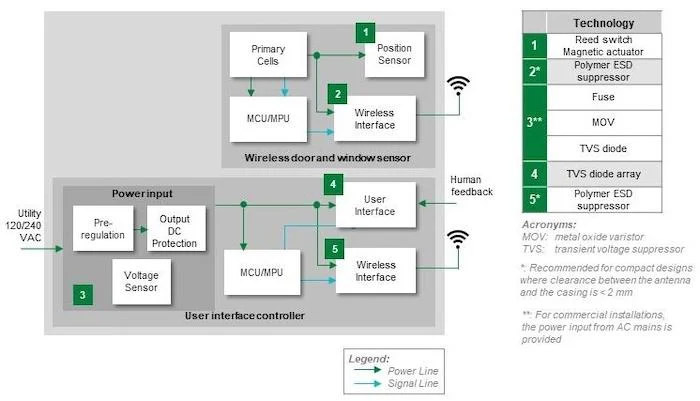
Figure 7. Block diagram of a window and door sensor system showing the circuit blocks and the recommended protection and sensing components
As with the smart lock, designers should consider a reed switch-magnetic actuator for proximity detection. With no activation power required, the reed switch extends the battery life of the sensor system. The Wireless Interface circuit blocks in the sensor and the user interface controller can use polymer ESD suppressors to ensure protection from ESD while maintaining the integrity of the RF transmission. Also similar to the smart lock, the User Interface circuit block with its keypad should have ESD protection from human contact. A TVS diode array can protect the sensitive signal lines from ESD transients.
Where AC power and an AC-DC power supply energize the User Interface Controller, designers need to protect the controller from potential threats from the AC line. Potential damage to the electronics can come from overcurrent conditions, lightning strikes and other voltage transients, and ESD transients. Designers can protect their designs from these conditions with fusing and voltage transient protection devices.
There are numerous options for fuses including the fuse’s operating characteristics and the case style to meet a wide range of design objectives. Designers should consider time-delay or slo-blo fuses to avoid nuisance shutdowns. In addition, designers should select the fuse current rating to accommodate short-term overloads such as in-rush currents where applicable. Other considerations include the interrupting rating which defines the maximum overload current the fuse can interrupt. This parameter trades off with fuse size. If a small fuse is needed, the designer will need to make sure that the fuse can withstand the available short circuit current supplied by the AC line. A final consideration is the fuses’ cold resistance. If power consumption is a prime concern, then designers should look for a fuse with low cold resistance.
To safely absorb the energy from a voltage transient on the AC line from lightning or motor turn-on and turn-off spikes, designers should consider employing a metal oxide varistor (MOV). MOVs can absorb a current surge as high as 10,000 A from an 8/20 µs transient pulse. A 20mm MOV can also absorb as much as 530 J of energy.
An alternative component to a MOV is a TVS diode. Models developed for protecting circuits from lightning and other transients can withstand as much as 1500 W of power from a 10/1000 µs pulse. To minimize power consumption, a TVS diode draws less than 1 µA under normal operating conditions. Furthermore, a TVS diode can respond quickly to a transient in less than 1 ps. Surface mount versions are available to minimize assembly labor. Figure 8 shows the symbols for a TVS diode. Designers can select either a bi-directional diode or a uni-directional diode.
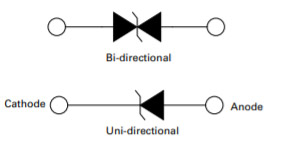
Figure 8. Configurations for a bi-directional and a uni-directional TVS diode
As with a smart lock, it does not take many components to protect window and door sensing circuits. Designers have a number of options to select the most suitable versions for their products.
Complying with the Industry Standards for Electronic Security Products
Designers should be knowledgeable of the standards that apply to the products they are developing so that they can incorporate the requirements during the development phase of their project. Failure to accommodate the standards can lead to potentially expensive re-design work and delays in product introduction.
In addition to general product safety standards such as the IEC 61000 series which define requirements for withstanding ESD, electrically fast transients, and lightning, specific standard exist for electronic locking and related products. Table 1 lists the applicable standards for electronic locking and related devices. These standards cover the North American market and China. The documents are essential reference materials for designers of smart locks and window and door sensors.
Table 1. Standards for Electronic Locking and Related Products for North America and China

Summary
A reputation for quality, reliability, and convenience is a tremendous competitive advantage for manufacturers of smart locks and window and door sensing products. Incorporating the appropriate protection and sensing components will contribute to achieving safe and robust products. Fortunately, designers only need a small number of components to fully protect their products and comply with safety standards. With low energy sensors, designers can maximize battery life to minimize the frequency of battery replacement. Designers have a number of alternative components that they can use. One final recommendation for achieving an optimal design is to take advantage of the expertise of the component manufacturers and seek their advice.
References
- Smart Lock Market Size. Grandview Research. February 2020.
- Window Sensors Market Outlook. Outlook Market Research. May 2019.
